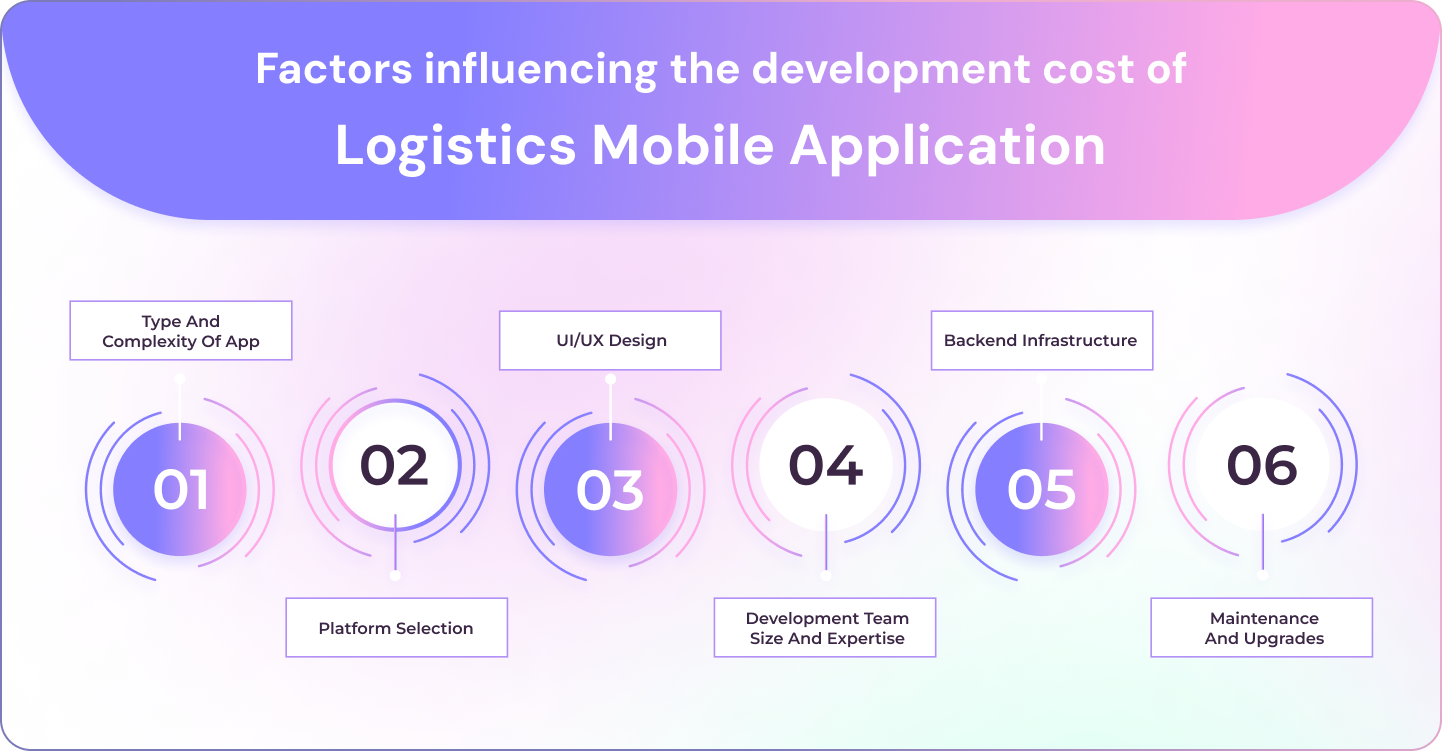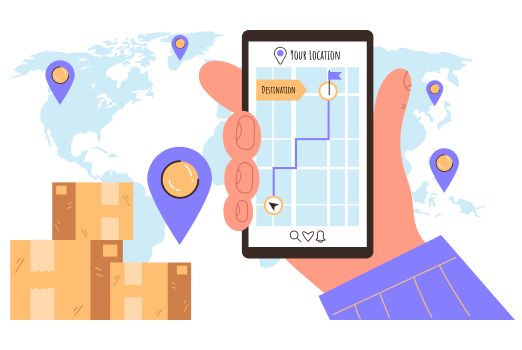How Much Does Logistics App Development Cost in 2025?
The logistics industry is undergoing a transformational evolution due to the developments in technology and increasing consumer expectations. With on-demand delivery apps, businesses from all sectors try to meet the need for speed, efficiency, and transparency in logistics operations. It is, therefore, important to know the cost dynamics of logistics app development in 2025 for those looking to invest in logistics software. This article gets into the dynamics of cost determination and gives insight about how a company can partner up with a strong logistics software development company to maximize ROI.
With increased e-commerce adoption, the criticality of appropriate logistics solutions would be more pivotal. Customers, today, also expect delivery without any hassles, real-time tracking, swift resolution of issues with the help of cutting-edge technology. On-demand delivery apps have changed the face of last-mile logistics. Companies are able to satisfy the demands of their customers, all while maximizing their resources. Building such apps would necessitate understanding the costs associated with them and the benefits of using a dedicated logistics software development company. Businesses focusing on innovative features and user-centric designs can develop impactful solutions that drive growth and operational excellence.
Factors Influencing Logistics App Development Costs

Several factors affect the cost of developing a logistics app in 2025. Here is the detailed breakdown:
1. Type and Complexity of App
The logistics apps could be as simple as a basic fleet tracking tool to complex on-demand delivery apps that provide real-time tracking, optimized routes, and advanced analytics. The cost mainly depends on the complexity of features that the app is supposed to offer:
Simple Apps: GPS tracking, simple reporting, user authentication.
Mid-Level Apps: Include route optimization, in-app communication, and real-time notifications.
Advanced Apps: Feature AI-driven predictive analytics, multi-language support, and integration with IoT devices for live monitoring.
2. Platform Selection
Will your app be available on Android, iOS, or both? Native apps (built specifically for one platform) typically cost more than cross-platform apps. With the rise of frameworks like Flutter and React Native, many businesses opt for cross-platform solutions developed by a seasoned logistics software development company to save time and costs.
3. UI/UX Design
A good app design guarantees the satisfaction and retention of users. Even though it would be expensive, an intuitive and aesthetically pleasing design would be worth every penny in terms of successful on-demand delivery apps.
4. Development Team Size and Expertise
The development team’s makeup—comprised of developers, designers, project managers, and quality assurance specialists—plays a role in cost. A development company with significant experience in logistics software will effectively manage the project and produce excellent results.
5. Backend Infrastructure
The backend of the app is the one that will be dealing with the database, user interactions, and third-party integrations. High-end backend systems with powerful APIs and cloud infrastructure drive up the development cost.
6. Maintenance and Upgrades
Post-launch maintenance is the process of ensuring the app works flawlessly. This includes updates, bug fixes, and feature enhancements in the overall budget.
Cost Breakdown of Logistics App Development
To make things clearer, let’s break down the cost into major components:
1. App Development
Basic Features: $10,000 – $30,000
Mid-Level Features: $30,000 – $70,000
Advanced Features: $70,000 – $150,000
The cost of the app development varies greatly considering the complexity and features of the app. Basic apps with fewer functionalities are cheap but may not fulfill the demand of an escalating business. Mid-level apps come in between costs and functionalities such as GPS tracking, route optimization, and the facility of providing reminders.
Advanced apps are suitable for large-scale operations featuring AI-driven analytics, IoT integration, real-time updates to enhance efficiency and user satisfaction.
2. UI/UX Design
Basic Design: $2,000-$7,000
Custom Design: $8,000-$20,000
Investment in UI/UX design is a must to retain users and ensure the app’s success. A basic design is suitable for simple apps that include the main layouts and interfaces. However, for an excellent user experience, customized designs based on your brand identity and user preference are worth extra money.
3. Platform Costs
Single Platform (Android or iOS): $10,000-$50,000
Cross-Platform: $20,000-$60,000
It has to be said that the decision of single-platform and cross-platform development affects the total cost. With cross-platform applications, built on frameworks like React Native, you can reach more users with lower costs compared to the development of different native applications for Android and iOS. It’s especially valuable for startups and small businesses.
4. Backend Development
Simple Backend: $5,000-$15,000
Advanced Backend with APIs: $20,000-$50,000
A strong backend will give a smooth execution and integration of third-party systems. Although a bare minimum backend suffices for tiny applications, full-fledged backends with API and cloud power are necessary in order to conduct complex logistics-related operations and guarantee scalability.
5. Maintenance Expenses
Monthly maintenance: $2,000-$5,000
Annual Maintenance: $15,000 – $50,000
Maintenance is essential to keep the app updated and secure. Monthly maintenance includes routine updates and bug fixes, while annual maintenance includes comprehensive upgrades and feature enhancements. It is important to set aside a part of your budget for maintenance so that the app stays competitive in the dynamic logistics industry.
Technologies Driving Logistics Apps in 2025
The cost of logistics app development is also determined by the integration of emerging technologies:
1. Artificial Intelligence (AI)
AI enhances decision-making by predicting delivery times, optimizing routes, and forecasting demand. While integrating AI adds to the cost, it significantly improves operational efficiency.
2. Internet of Things (IoT)
IoT devices monitor vehicle conditions, track shipments, and provide real-time updates. Developing IoT-compatible logistics apps involves additional investment but offers unmatched transparency and control.
3. Blockchain
Blockchain ensures tamper-proof records for supply chain transactions. Inclusion of blockchain features incurs additional development costs but reduces fraud and increases trust.
4. Cloud Computing
Cloud-based logistics apps ensure scalability and real-time access to data. Collaboration with a logistics software development company that has experience in cloud integration can ensure the best possible cost optimization without compromising on reliability.
5. Big Data Analytics
Advanced analytics help in generating actionable insights regarding performance metrics and customer behavior, thereby ensuring data-driven decisions.
Advantages of a Logistics Software Development Company
Creating logistics apps demands expertise in multiple domains. Partnering with a trusted logistics software development company has several benefits:
1. Customized Solutions
An expert team makes sure that the app is created according to your business needs. It could be fleet management or on-demand delivery apps.
2. Cost-Effective Development
Experienced developers use their skills to optimize the process, hence reducing the time and cost of developing the app.
3. Scalability
A professional logistics software development company designs applications that can scale with your business.
4. System Upkeep
Maintenance, upgrades as well as continued support to ensure your app stays competitive.
Key Features Every Successful On-Demand Delivery App Should Have
On-demand delivery apps should provide features to enhance the user experience. Here is a must-have functionality for an on-demand delivery app.
1. Real-time tracking
Users should be able to track the shipments and deliveries in real-time. This increases the level of transparency.
2. Route Optimization
Makes use of AI to find the best delivery routes for time and fuel cost savings.
3. Multi-Language Support
It is the most important factor for reaching the global audience.
4. Payment Integration
Multi-payment options make it easy to use.
5. Feedback and Ratings
Helps users leave feedback, allowing businesses to upgrade their services.
6. Inventory Management
Stock levels are monitored, and when low, alerts for replenishment.
Cost-Saving Tips for Logistics App Development
While logistics app development can be costly, the following strategies can help optimize your budget:
1. Start Small
Begin with a Minimum Viable Product (MVP) to test the market and gather user feedback before investing in additional features.
2. Opt for Cross-Platform Development
Using frameworks like Flutter or React Native reduces development time and costs by creating a single app for both iOS and Android.
3. Choose an Experienced Partner
Work with a logistics software development company that has a track record of successful high-quality solutions.
4. Prioritize Must-Have Features
Features that fit within your business model and are capable of generating value quickly
Conclusion
The cost of logistics app development in 2025 depends upon several factors like the complexity of the application, the platform for which it will be developed, and technology integrations. Starting from basic to more advanced applications like on-demand delivery with AI and IoT integration may range from $20,000 to over $150,000. With the help of a trusted logistics software development company, you get your customized and scalable solution according to your requirements.
Businesses will be able to enhance operational efficiency, improve customer satisfaction, and gain a competitive edge in the fast-evolving logistics landscape with investment in a logistics app. Strategic planning is a must, prioritize the essential features, and have the right partnership that can bring the vision to reality.
FAQs( Frequently Asked Question)
1. What is the average cost of logistics app development in 2025?
: The cost of logistics app development in 2025 ranges from $20,000 for basic apps to over $150,000 for advanced apps with cutting-edge features like AI and IoT integration.
2. What factors influence the cost of developing a logistics app?
: The cost depends on factors like app complexity, platform selection (Android, iOS, or cross-platform), UI/UX design, backend infrastructure, and the inclusion of advanced technologies such as AI, IoT, or blockchain.
3. How much does it cost to develop an on-demand delivery app?
: A development cost for an on-demand delivery application ranges between $30,000 and $150,000 based on the complexity, features included, such as real-time tracking, route optimization, and payment integration, and many others.
4. Is cross-platform development cheaper than native app development?
: Yes, cross-platform development using frameworks like Flutter or React Native is more cost-effective since you can build one app for both Android and iOS, reducing the time spent on development and the expenses.
5. How much does basic UI/UX design for a logistics app cost?
: Basic UI/UX design will cost you between $2,000 and $7,000. However, custom designs based on your brand and user needs can range between $8,000 and $20,000.
6. How much should I spend on app maintenance and updates?
:Monthly maintenance can cost between $2,000 and $5,000; annual maintenance is between $15,000 and $50,000, depending on the complexity of the app.
7. Does this really add a significant amount to development costs?
: Indeed, advanced features such as AI-driven analytics and IoT compatibility are expensive but provide great operational efficiency, scalability, and user experience.
8 What is the difference in cost between a single-platform and cross-platform logistics app?
: A single-platform app (Android or iOS) will cost between $10,000 and $50,000. Cross-platform apps range from $20,000 to $60,000 and allow for broader audience reach at a lower incremental cost.
9 Can I reduce development costs by starting with a Minimum Viable Product (MVP)?
: Indeed, it is possible to develop an MVP with core features first, allowing one to test the market and receive user feedback before investing in further functionalities, reducing initial costs.
10 Why should I partner with a logistics software development company?
: Access to expert developers, cost-effective solutions, and scalable designs will be guaranteed once you partner with a logistics software development company and align it to your specific business needs.
TABLE OF CONTENT
- How Much Does Logistics App Development Cost in 2025?
- Factors Influencing Logistics App Development Costs
- Cost Breakdown of Logistics App Development
- Technologies Driving Logistics Apps in 2025
- Advantages of a Logistics Software Development Company
- Key Features Every Successful On-Demand Delivery App Should Have
- Cost-Saving Tips for Logistics App Development
- Conclusion
